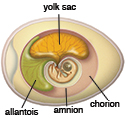
The hatching of a chick out of an egg — whether laid by a chicken, duck, goose, or other bird — is a remarkable process. Each chick enters the world with a built-in food supply that can sustain it for up to three days after the bird hatches. How does this happen?
Starting on the first day of incubation, four systems of membranes develop inside the egg that help an embryo develop, live, and grow. Because they do not become part of the hatchling’s body, they are called extraembryonic membranes. These support membranes are as follows:
Yolk Sac or Vitelline Sac
This membrane surrounds the yolk and is where the first blood vessels form during the first day of incubation. Its function is to transport nutrients from the yolk to the embryo. As the embryo grows and the yolk gets used up, this membrane shrinks.
Allantois
This sac arises from the embryo’s gut, starting on the third day of incubation. Structurally the allantois is similar to the yolk sac and, in fact, the two systems work together to function much like a mammal’s umbilical cord. As a chick embryo develops, using up nutrients from the yolk and expelling wastes into the allantois, the allantois grows until it completely surrounds the embryo. Its function is to provide the embryo with oxygen, expel carbon dioxide, deliver nutrients from the albumen and calcium from the shell, and collect body waste — that’s the greenish gunk you find on the hatching tray when you hatch eggs in an incubator.
Amnion
This innermost membrane begins developing on the third day of incubation and surrounds only the embryo. It is filled with colorless amniotic fluid in which the embryo floats — providing a stable environment that gives the embryo freedom to move and exercise, protects it from jarring impacts, and prevents it from drying out.
Chorion
This membrane is an overall enclosure that surrounds and protects the embryo and its support systems. As the allantois grows within the chorion, it eventually touches the chorion near the egg’s blunt end and the allantoic membrane begins to fuse with the chorion. By the time the allantois surrounds the embryo, the allantoic membrane and the chorion membrane have merged. This chorio-allantoic membrane keeps growing, until by the sixteenth day of incubation it nearly fills the inside of the shell. It stops functioning just before the hatch, as soon as the embryo breaks into the air cell and begins using its lungs to breathe.
By the time the bird hatches, not all of the nutritious yolk material in the yolk sac has been used up. What remains is drawn into the chick’s abdomen and absorbed by the chick’s body during its first three days of life. Nature provides these reserve nutrients because eggs incubated under a hen don’t all hatch at the same time. The early hatchers therefore have sufficient reserves to hang around under the hen waiting for the stragglers to catch up. Even when all the eggs hatch at nearly the same time, the extra yolk reserves give hatchlings plenty of time to learn what to eat and drink and where to find it.
Eggs that are incubated at a hatchery are timed to hatch all at once, so the chicks all have the same amount of yolk reserves and can be shipped together, giving them three days before they need to start drinking water and eating chick starter.
Cackle Hatchery schedules baby chick shipments for two days of the week. Monday shipments are scheduled to arrive no later than Wednesday. Wednesday shipments are scheduled to arrive no later than Saturday. Either way, the chicks don’t have to spend a weekend waiting at a postal facility. Further, since chicks are shipped from February to October, and the weather keeps changing throughout that time, different shipping materials are used — depending on the time of year and the current travel conditions — to keep the chicks comfy during their journey.
And that’s today’s news from the Cackle Coop.
Gail Damerow, author, Hatching and Brooding Your Own Chicks (Chickens, Turkeys, Ducks, Geese, Guinea Fowl)


We ordered our chicks and got a ship date of June 7th, we were surprised to see our delivery date was June 10th by the tracking info. Seemed like a long time in the box but we assumed that Cackle was the expert and knew what they were doing. We had our brooder box all set up with our red light setting the temperature at 105 degrees in the straw, we had our water temperature at 100 degrees and watched as the tracking info told us our chicks were at our post office at 7:35 am, a few minutes later the phone rang and the PO told us the chicks were in. We excitedly drove the 6 blocks to the PO and were given our little box of chicks. We rushed home and opened the box to take our chicks out and dip their little beaks into the water. Our day was ruined as we looked at our 5 dead little chicks with three more that were not going to make it. This has to go down as one of those very disappointing days in your life that you never forget.
I’m so sorry to hear that! Did you contact us?
I just received my brooder start kit and was keeping the chicks in my home when they arrive. Can I put down plastic to protect the floor then put the pine shavings then some new paper. I don’t want to hurt them.